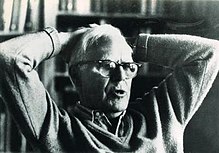
Back مارتن غاردنر Arabic مارتن جاردنر ARZ مارتین قاردنر AZB Мартин Гарднър Bulgarian Martin Gardner Catalan Martin Gardner Czech Martin Gardner Danish Martin Gardner German Martin Gardner Esperanto Martin Gardner Spanish
Martin Gardner | |
|---|---|
 | |
| Born | October 21, 1914 Tulsa, Oklahoma, U.S. |
| Died | May 22, 2010 (aged 95) Norman, Oklahoma, U.S. |
| Occupation | Author |
| Alma mater | University of Chicago |
| Genre | Recreational mathematics, puzzles, close-up magic, annotated literary works, debunking |
| Literary movement | Scientific skepticism |
| Notable works | Fads and Fallacies in the Name of Science, "Mathematical Games" (Scientific American column), The Annotated Alice, The Whys of a Philosophical Scrivener, The Ambidextrous Universe |
| Notable awards | Leroy P. Steele Prize for Mathematical Exposition (1987)[1] George Pólya Award (1999)[2][3] Allendoerfer Award (1990) Trevor Evans Award (1998) |
| Spouse |
Charlotte Greenwald (m. 1952) |
| Children | 2 |
| Signature | |
Martin Gardner (October 21, 1914 – May 22, 2010) was an American popular mathematics and popular science writer with interests also encompassing magic, scientific skepticism, micromagic, philosophy, religion, and literature – especially the writings of Lewis Carroll, L. Frank Baum, and G. K. Chesterton.[4][5] He was a leading authority on Lewis Carroll;[6] The Annotated Alice, which incorporated the text of Carroll's two Alice books, was his most successful work and sold over a million copies.[7] He had a lifelong interest in magic and illusion and in 1999, MAGIC magazine named him as one of the "100 Most Influential Magicians of the Twentieth Century".[8] He was considered the doyen of American puzzlers.[9] He was a prolific and versatile author, publishing more than 100 books.[10][11]
Gardner was best known for creating and sustaining interest in recreational mathematics—and by extension, mathematics in general—throughout the latter half of the 20th century, principally through his "Mathematical Games" columns.[12][13] These appeared for twenty-five years in Scientific American, and his subsequent books collecting them.[14][15]
Gardner was one of the foremost anti-pseudoscience polemicists of the 20th century.[16] His 1957 book Fads and Fallacies in the Name of Science[17] is a seminal work of the skeptical movement.[18] In 1976, he joined with fellow skeptics to found CSICOP, an organization promoting scientific inquiry and the use of reason in examining extraordinary claims.[19]
- ^ Cite error: The named reference
allyn_jacksonwas invoked but never defined (see the help page). - ^ "MAA Writing Awards Presented" (PDF). Notices of the AMS. 47 (10): 1282. November 2000. Archived (PDF) from the original on July 12, 2014.
- ^ Gardner, Martin (January 1999). "The Asymmetric Propeller" (PDF). The College Mathematics Journal. 30 (1): 18–22. doi:10.2307/2687198. JSTOR 2687198. Archived (PDF) from the original on March 4, 2014.
- ^ Martin (2010)
- ^ Singmaster, D. (2010) "Obituary: Martin Gardner (1914–2010)" Nature 465(7300), 884.
- ^ Kindley (2015): When it comes to explanations of Carroll’s books, no one has yet improved on the work of Gardner.
- ^ Martin Gardner obituary Telegraph Media Group (2010)
- ^ Cite error: The named reference
magicwas invoked but never defined (see the help page). - ^ Costello (1988): p. 114.
- ^ England (2014): Even apart from mathematics and puzzles, Gardner's output was staggering.
- ^ "Martin Gardner dies at 95; prolific mathematics columnist for Scientific American" by Thomas H. Maugh, Los Angeles Times, May 26, 2010
- ^ AMS Notices (2011): "Martin Gardner was a gem. There is absolutely no question that he, more than anyone else in the world, was responsible for turning people of all ages on to the pleasures of mathematical recreations." —Ronald L. Graham
- ^ Case 2014: Gardner is credited with the rebirth of recreational mathematics in the U.S.
- ^ Martin (2010): "His mathematical writings intrigued a generation of mathematicians."
- ^ Bellos (2010): "He became a kind of father figure to a generation of young mathematicians, who corresponded with him. Such was Gardner's influence between the late 1950s and 1980s that it would be hard to find a professional mathematician from those years who does not cite him as an inspiration."
- ^ "Martin Gardner – Mathematician". Martin Gardner Home Site. Gathering 4 Gardner. 2014. Archived from the original on November 18, 2016. Retrieved October 28, 2016.
- ^ originally published in 1952 as In the Name of Science: An Entertaining Survey of the High Priests and Cultists of Science, Past and Present
- ^ Shermer, Michael (2001). The Borderlands of Science: Where Sense Meets Nonsense. Oxford University Press. p. 50. Retrieved May 20, 2016.
Fads and Fallacies in the Name of Science [is] still in print and arguably the skeptic classic of the past half-century.
- ^ "About CSI". Committee for Skeptical Inquiry. Archived from the original on November 12, 2016. Retrieved October 28, 2016.